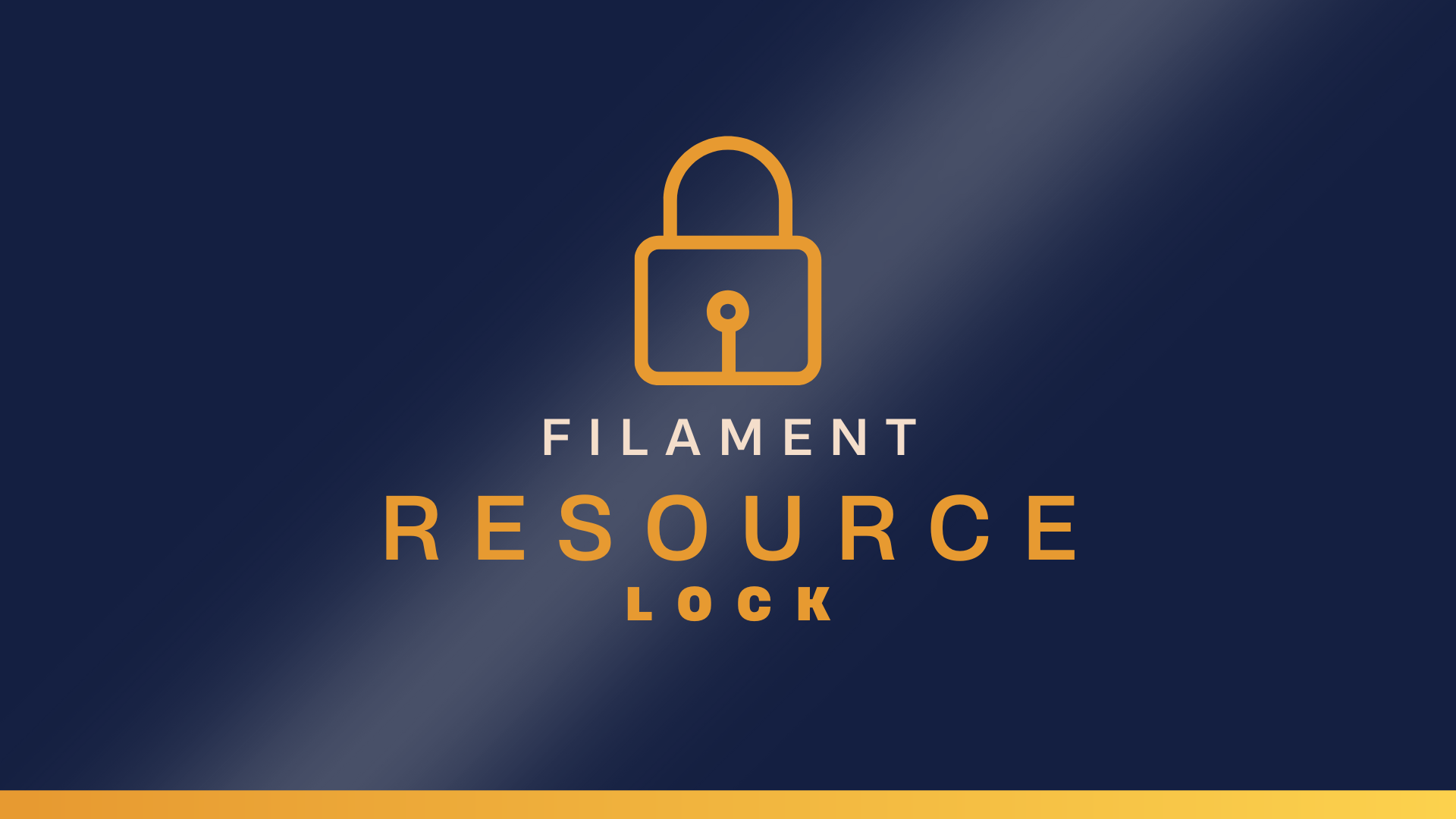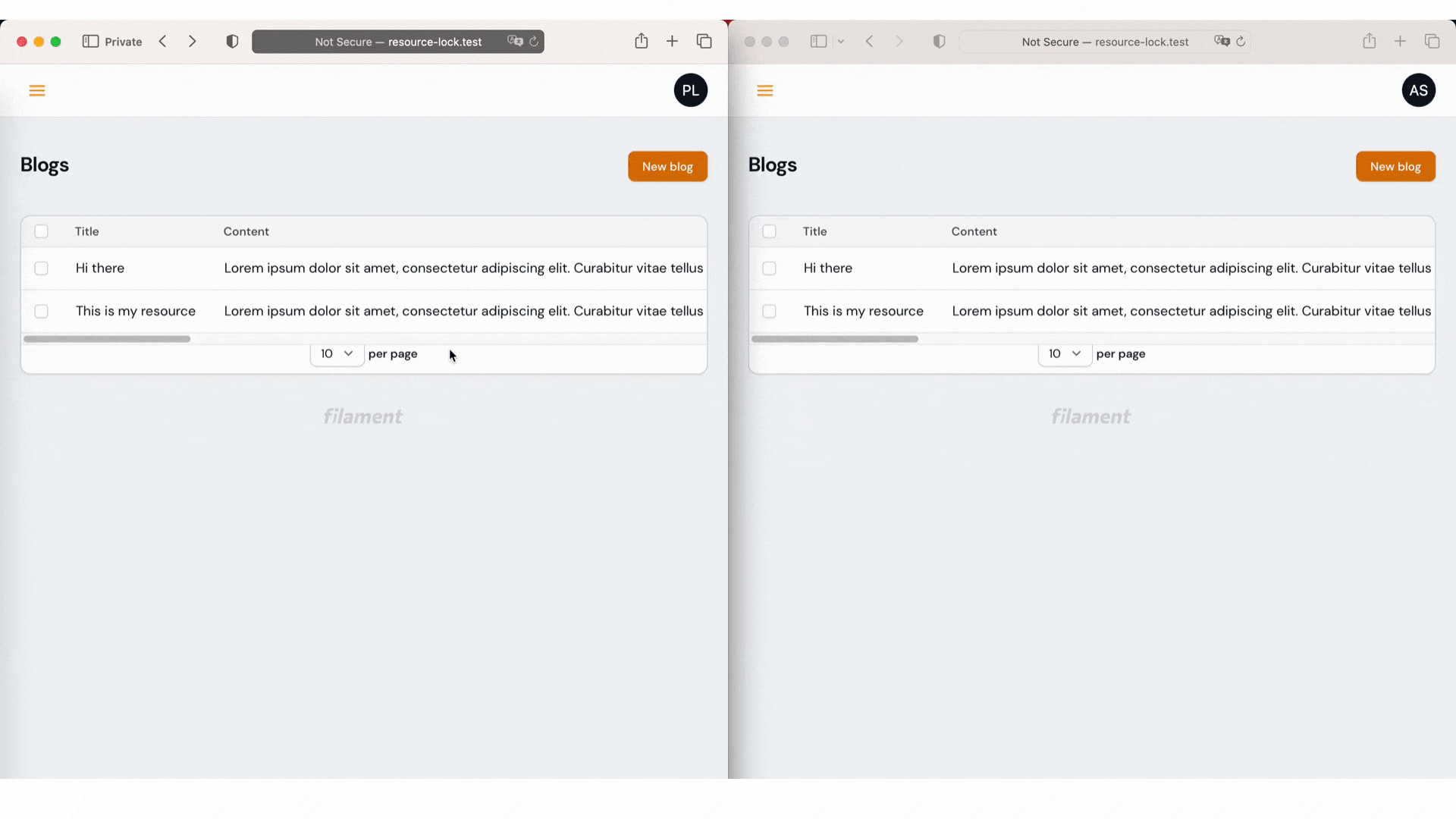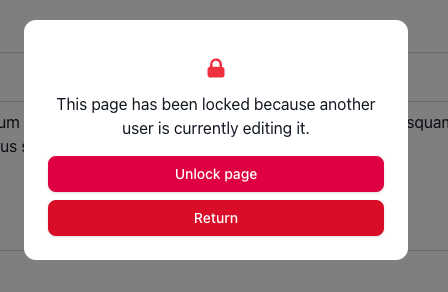Resource lock
Plugin information
by Kenepa
The Resource Lock plugin adds automatic resource locking while editing to prevent simultaneous edits. Unlocks after set time or changes saved/discard
by Kenepa
The Resource Lock plugin adds automatic resource locking while editing to prevent simultaneous edits. Unlocks after set time or changes saved/discard

Filament Resource Lock is a Filament plugin that adds resource locking functionality to your site. When a user begins editing a resource, Filament Resource Lock automatically locks the resource to prevent other users from editing it at the same time. The resource will be automatically unlocked after a set period of time, or when the user saves or discards their changes.

You can install the package via composer:
composer require kenepa/resource-lockYou can run the installation command to publish config files, migrations and run migrations (optional)
php artisan resource-lock:installThe Filament Resource Lock package enables you to lock a resource and prevent other users from editing it at the same time. Currently, this package only locks the EditRecord page and the edit modal when editing a simple modal resource. Follow the steps below to add locks to your resources.
The first step is to add the HasLocks trait to the model of your resource. The HasLocks trait enables the locking functionality on your model.
// Post.php use Kenepa\ResourceLock\Models\Concerns\HasLocks; class Post extends Model{ use HasFactory; use HasLocks; protected $table = 'posts'; protected $guarded = [];}The second step is to add the UsesResourceLock trait to your EditRecord page. The UsesResourceLock trait enables the locking function on your edit page.
// EditPost.php use Kenepa\ResourceLock\Resources\Pages\Concerns\UsesResourceLock; class EditPost extends EditRecord{ use UsesResourceLock; protected static string $resource = PostResource::class;}If your resource is a simple modal resource, you'll need to use the UsesSimpleResourceLock trait instead.
// ManagePosts.php use Kenepa\ResourceLock\Resources\Pages\Concerns\UsesSimpleResourceLock; class ManagePosts extends ManageRecords{ use UsesSimpleResourceLock; protected static string $resource = PostResource::class; }And that's it! Your resource is now able to be locked. Refer to the documentation below for more information on how to configure the locking functionality.

The package also provides a simple way to manage and view all your active and expired locks within your app. And it also provides a way to quickly unlock all resources or specific locks.

You can restrict the access to the Unlock button or to the resource manager by adjusting the access variable. Enabling the "limited" key and setting it to true allows you to specify either a Laravel Gate class or a permission name from the Spatie Permissions package.
// resource-lock.php /* |-------------------------------------------------------------------------- | Resource Unlocker |-------------------------------------------------------------------------- | | The unlocker configuration specifies whether limited access is enabled for | the resource lock feature. If limited access is enabled, only specific | users or roles will be able to unlock locked resources. | */ 'unlocker' => [ 'limited_access' => true, 'gate' => 'unlock-resource' ],Example
// Example using gatesGate::define('unlock-resource', function (User $user, Post $post) { return $user->email === 'admin@mail.com';}); // Example using spatie permission packagePermission::create(['name' => 'unlock-resource']);Sometimes, you may have a customized implementation for the User model in your application, or you may want to use a custom class for the ResourceLock functionality. In such cases, you can update the configuration file to specify the new class you want to use. This will ensure that the ResourceLock functionality works as expected with the new implementation.
// resource-lock.php /* |-------------------------------------------------------------------------- | Models |-------------------------------------------------------------------------- | | The models configuration specifies the classes that represent your application's | data objects. This configuration is used by the framework to interact with | the application's data models. You can even implement your own ResourceLock model. | */ 'models' => [ 'User' => \App\Models\CustomUser::class, 'ResourceLock' => \App\Models\CustomResourceLock::class, ],Use the display_resource_lock_owner within the resource-lock.php config to control whether or not the locked
resource owner is
displayed in the modal. Set the option to true to show the owner's username or other identifying information. The
modal
can be triggered by a button click or automatically when the resource is accessed.
By default, the package displays the name of the user: $userModel->name. However, if your user model doesn't have
a name or you want to display a different identifier, you can create a custom action to overwrite the default behavior.
This package uses actions which allows you to implement your own custom logic. An action class is nothing more than a simple class with a method that executes some logic. Learn more about actions
To create a custom action, first create a file within your project and name
it CustomGetResourceLockOwnerAction.php, for
example. In this file, create a new class that extends the GetResourceLockOwnerAction class and override the
execute
method to return the desired identifier. For example:
// CustomGetResourceLockOwnerAction.php namespace App\Actions; use Kenepa\ResourceLock\Actions\GetResourceLockOwnerAction; class CustomResourceLockOwnerAction extends GetResourceLockOwnerAction{ public function execute($userModel): string|null { return $userModel->email; }}Next, register your custom action within the resource-lock.config file. Replace the default get_resource_lock_owner_action value with your custom action's class name. For example:
// resource-lock.php 'actions' => [- 'get_resource_lock_owner_action' => \Kenepa\ResourceLock\Actions\GetResourceLockOwnerAction::class+ 'get_resource_lock_owner_action' => \Kenepa\ResourceLock\Actions\CustomGetResourceLockOwnerAction::class ],If you need some custom functionality beyond what the traits provide, you can override the functions that they use. For example, if you want to change the URL that the "Return" button redirects to, you can override the resourceLockReturnUrl() function. By default, this button takes you to the index page of the resource, but you can change it to whatever URL you want by adding your custom implementation in the resourceLockReturnUrl() function.
For instance, if you want the "Return" button to redirect to https://laracasts.com, you can override the function as follows:
public function resourceLockReturnUrl(): string{ return 'https://laracasts.com';}Now the return url will redirect to laracasts.com
This will change the behavior of the "Return" button to redirect to the provided URL.
php artisan vendor:publish --tag="resource-lock-migrations"php artisan migrateYou can publish and run the migrations with:
php artisan vendor:publish --tag="resource-lock-migrations"php artisan migrateYou can publish the config file with:
php artisan vendor:publish --tag="resource-lock-config"Optionally, you can publish the views using
Note: Publishing Blade views can introduce breaking changes into your app. If you're interested in how to stay safe, see this article by Dan Harrin.
php artisan vendor:publish --tag="resource-lock-views"Please see CHANGELOG for more information on what has changed recently.
Please see CONTRIBUTING for details.
The MIT License (MIT). Please see License File for more information.